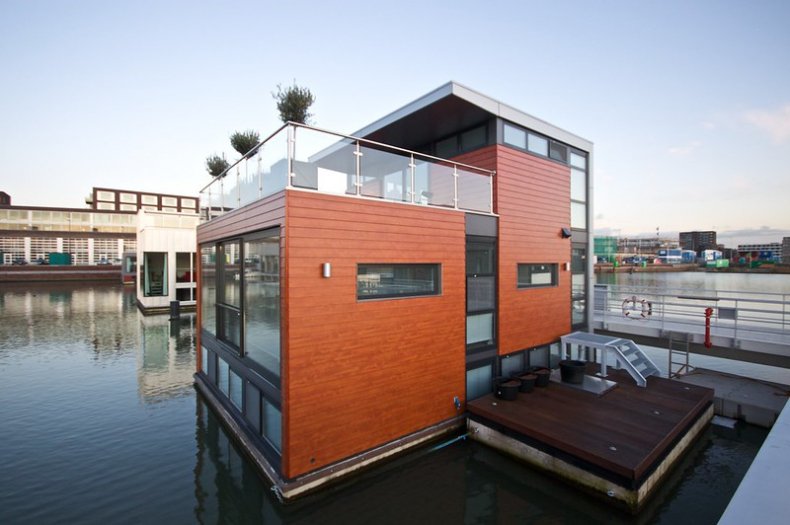This story was originally published by Yale Environment 360 and appears here as part of the Climate Table collaboration.
When a severe storm hit in October, residents of Amsterdam’s floating community of Schoonschip had little doubt they could weather it. They tied up their bikes and benches outside, checked in with neighbors to make sure everyone had enough food and water, and huddled together as their neighborhood slid up and down its steel pillars, rising along with the water and descending to its original position after the rain subsided.
“We feel safer in a storm because we are floating,” said Siti Boelen, a Dutch television producer who moved to Schoonschip two years ago. “I think it’s a bit strange that building on water is not a priority around the world.”
As sea levels rise and supercharged storms cause waters to swell, floating neighborhoods offer a flood defense experiment that could allow coastal communities to better resist climate change. In the land-scarce but densely populated Netherlands, the demand for this type of housing is growing. And, as more people look to build on water there, officials are working to update zoning laws to make it easier to build houseboats.
“The municipality wants to expand the floating concept because it is a multifunctional use of space for housing, and because the sustainable path is the way forward,” said Nienke van Renssen, Amsterdam city councilor for the GreenLeft party.
The floating communities in the Netherlands that have emerged in the last decade have served as proof of concept for large-scale projects that are now spearheaded by Dutch engineers, not only in European countries like Britain, France and Norway, but also in places so far away. Launched as French Polynesia and the Maldives, the Indian Ocean nation now faces an existential threat from rising sea levels. There is even a proposal for floating islands in the Baltic Sea on which small cities would be built.
A houseboat can be built on any coastline and is capable of coping with rising sea levels or flooding caused by rain floating on the surface of the water. Unlike houseboats, which can be easily disassembled and relocated, houseboats are fixed to shore, often resting on steel poles, and generally connected to the local sewer system and the electrical grid. They are structurally similar to houses built on land, but instead of a basement, they have a concrete shell that acts as a counterweight, allowing them to remain stable in the water. In the Netherlands, they are often prefab, square, three-story townhouses built off-site from conventional materials such as wood, steel, and glass. For cities facing worsening flooding and a shortage of building land, houseboats are a potential blueprint for how to expand urban housing in the age of climate change.
What people are reading

Koen Olthuis, who in 2003 founded water study, a Dutch architecture firm focused exclusively on floating buildings, said that the relatively low-tech nature of houseboats is potentially their biggest advantage. The houses he designs are stabilized by posts dug approximately 65 meters into the ground and fitted with shock-absorbing materials to reduce the sensation of movement from nearby waves. Houses rise when the waters rise and fall when the waters recede. But despite their apparent simplicity, Olthuis argues that they have the potential to transform cities in ways never seen since the elevator’s introduction, which pushed horizons upward.
“Now we have the technology, the ability to build on water,” said Olthuis, who has designed 300 houseboats, offices, schools and healthcare facilities. He added that he and his colleagues “do not see ourselves as architects, but as city doctors, and we see water as medicine.”

In the Netherlands, a country built largely on reclaimed land and a third of which remains below sea level, the idea is not so far-fetched. In Amsterdam, which has nearly 3,000 traditional houseboats officially registered on its canals, hundreds of people have moved onto houseboats in previously underserved neighborhoods.
These floating communities are inspiring more ambitious Dutch-led projects in flood-prone nations as far away as French Polynesia and the Maldives. #ClimateChange #FloatingHomes
Schoonschip, designed by the Dutch firm Space and Matter, consists of 30 houses, half of which are duplexes, on a canal in an old industrial area. The neighborhood is a short ferry ride from the center of Amsterdam, where many of the residents work. Community members share almost everything, including bicycles, cars, and food purchased from local farmers. Each building has its own heat pump and dedicates about a third of its roof to green areas and solar panels. Residents sell excess energy to each other and to the national grid.
“Living off water is normal for us, which is exactly the point,” said Marjan de Blok, a Dutch television director who started the project in 2009 by organizing the collective of architects, legal experts, engineers and residents who worked to achieve the soil project.
Rotterdam, which lies 90% below sea level and is the site of Europe’s largest port, is home to the world largest floating office building, as well as a floating farm where cows are milked by robots, supplying dairy products to local grocery stores. Since the 2010 launch of the Floating pavilion, a solar-powered meeting and event space in the Port of Rotterdam, the city has been stepping up its efforts to incorporate such projects, naming floating buildings as one of the pillars of its Climate adaptation and resistance strategy.
“Over the last 15 years, we have reinvented ourselves as a delta city,” said Arnoud Molenaar, City of Rotterdam Resilience Director. “Instead of seeing water as an enemy, we see it as an opportunity.”
To help protect cities against climate change, in 2006 the Dutch government carried out its “Space for the River” program, which strategically allows certain areas to flood during periods of heavy rain, a paradigm shift that seeks to embrace , instead of resisting, the rise of the water level. levels. Olthuis says that the housing shortage in the Netherlands could boost demand for floating homes, even in “Room for the River” areas where flooding will, for at least part of the year, be part of the landscape. Experts say that alleviating the housing shortage in the Netherlands will require the construction of a million new houses over the next 10 years. Houseboats could help offset shortage of land suitable for urbanization.
Dutch companies specializing in floating buildings have been inundated with requests from overseas developers to undertake more ambitious projects. Blue21, a Dutch technology company focused on floating buildings, is now working on a proposed series of Floating Islands in the Baltic Sea that would house 50,000 people and connect to a privately funded 15 billion euro underwater railway tunnel linking Helsinki, Finland and Tallinn, Estonia; The project is backed by Finnish investor and Angry Birds entrepreneur Peter Vesterbacka.
Waterstudio will oversee the construction this winter of a floating home development near the lower capital of Malé in the Maldives, where 80 percent of the country is less than one meter above sea level. It is made up of affordable and simply designed housing for 20,000 people. Under the hulls there will be artificial coral to help support marine life. The buildings will pump cold seawater from the depths to power air conditioning systems.
Floating city projected for the Maldives, threatened by rising sea levels.
“There is no longer the idea of a mad wizard building a houseboat,” Olthuis said. “Now we are creating blue cities, seeing water as a tool.”
However, houseboats pose numerous challenges. Strong winds and rainstorms, or even the passing of large cruise ships, can cause buildings to sway. Schoonschip resident Siti Boelen said that when she first moved in, the stormy weather made her think twice before venturing up to the third-floor kitchen, where she felt the most movement. “You feel it in your stomach,” he said, adding that he has since gotten used to the sensation.
Houseboats also require additional infrastructure and work to connect to the electrical grid and sewer system, with special waterproof cables and pumps needed to connect to municipal services on higher ground. In the case of Schoonschip in Amsterdam and the floating office building in Rotterdam, new microgrids had to be built from scratch.
But the benefits may outweigh the costs. Rutger de Graaf, co-founder and director of Blue21, said that the increasing number of disastrous and unprecedented storms around the world has prompted both planners and residents to seek solutions on the water. Floating developments, he said, could have saved lives and billions of dollars in damage as recently as last summer, when deadly floods hit Germany and Belgium, killing at least 222 people.
“If there are floods, a lot of people are expected to move to higher ground. But the alternative is to stay close to the coastal cities and explore expansion into the water, ”says De Graaf. “If you consider that in the second half of the century, hundreds of millions of people will be displaced by rising sea levels, we must now begin to scale up floating developments.”
Reference-www.nationalobserver.com